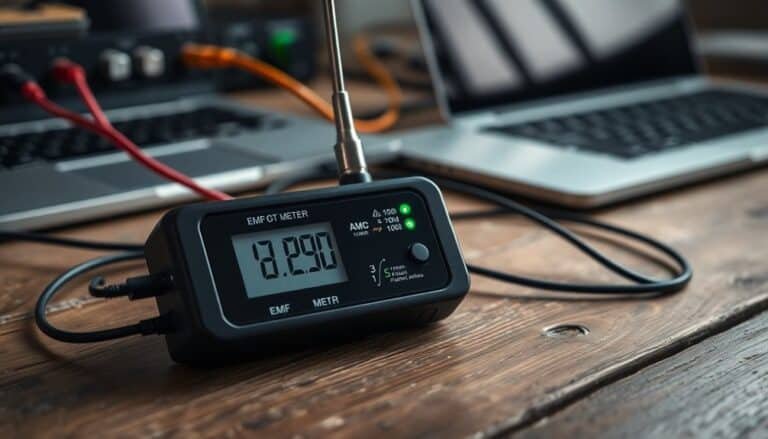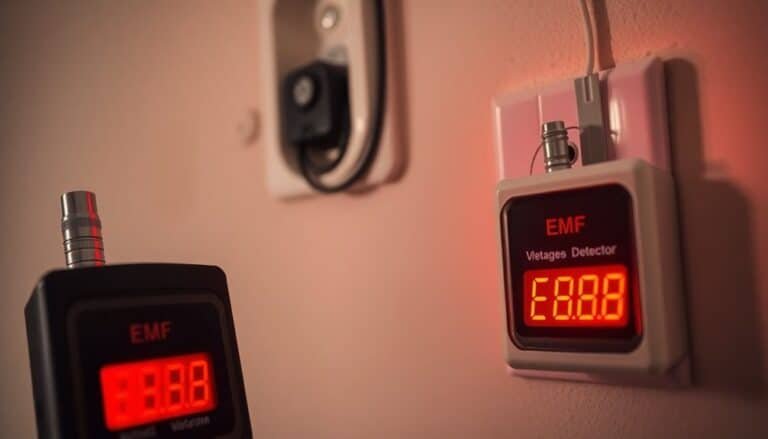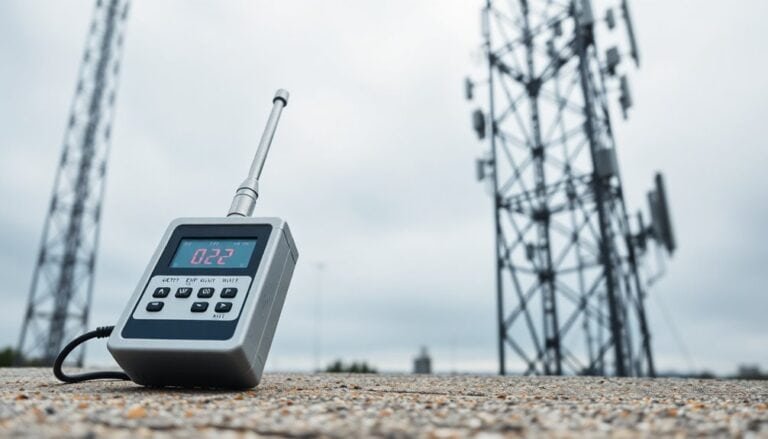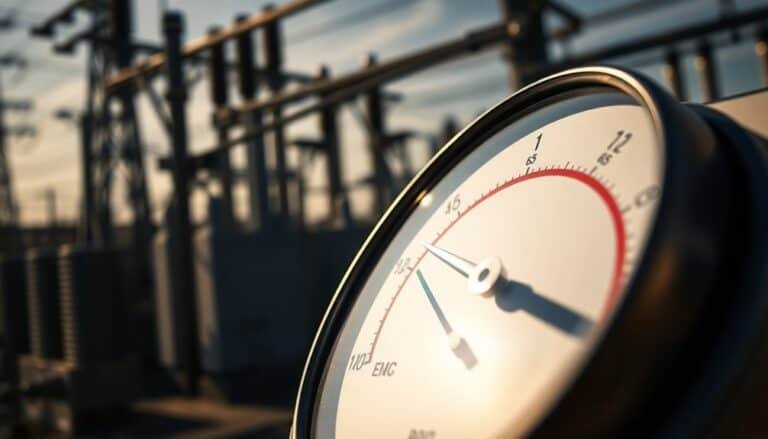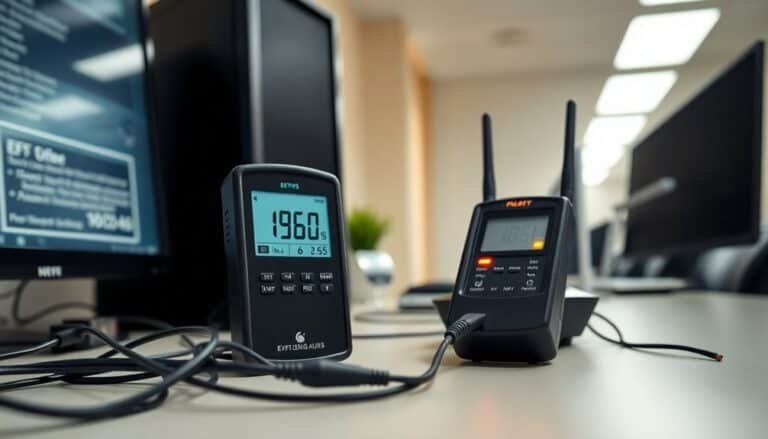How to Detect EMF Without a Meter (Creative Ways)

Detect EMF creatively without a meter by using coil-based DIY detectors or observing plant growth patterns to identify hotspots. Old radios and RF antennas can also passively detect signals, with electronics exhibiting unusual behaviors near EMF sources.
Innovative materials can enhance detection sensitivity, and continued exploration may reveal more methods.
Disclaimer: As an affiliate, I may collect a share of sales from the links on this page.
Spectrum Analyzers: Understanding the Basics
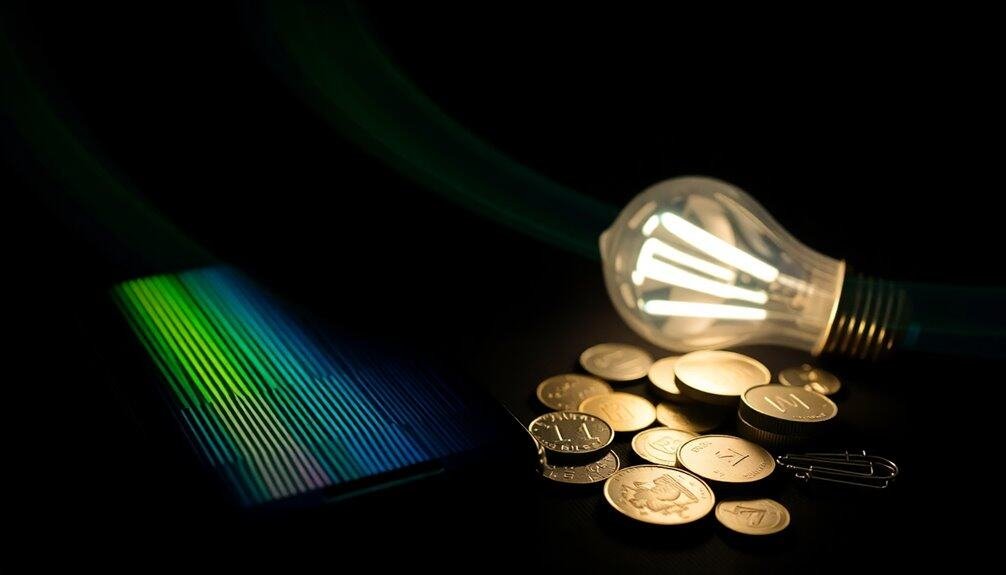
Spectrum analyzers are essential tools for measuring and visualizing signal spectra. They operate by sweeping frequencies, displaying signal amplitude versus frequency.
Utilizing the superheterodyne principle, these devices mix input signals with locally generated frequencies to produce lower frequency signals for analysis. Spectrum analyzers process various input types, from simple sinusoidal to complex waveforms. The four essential parameters needed for operation—center and span, reference level, resolution bandwidth, and video bandwidth—play a crucial role in achieving accurate measurements.
The resolution bandwidth (RBW) controls frequency resolution; a narrower RBW enhances resolution but prolongs sweep time.
With applications in laboratories, communication systems testing, and electromagnetic interference analysis, spectrum analyzers are vital for precise signal analysis. Understanding these basics allows you to use them effectively in your work.
Oscilloscope Techniques for EMF Visualization
When visualizing electromagnetic fields (EMF) with an oscilloscope, it’s important to understand the various techniques you can use to capture and analyze signals efficiently.
Choose a Digital Phosphor Oscilloscope (DPO) for complex waveforms. Connect probes at various circuit points to view voltage waveforms. Utilize real-time frequency analysis software for immediate insights. Oscilloscopes analyze electrical signals effectively by providing time and voltage values which are crucial for understanding waveform behavior.
Display waveforms traditionally or analyze complex signals through intensity grading. Enhance representation using 3D and color views for additional data dimensions.
Leverage on-screen measurements for real-time data and employ proper probe placement to guarantee accuracy. Adjust triggering settings for stable captures, enhancing overall analysis quality.
Utilizing RF Antennas for Passive EMF Detection
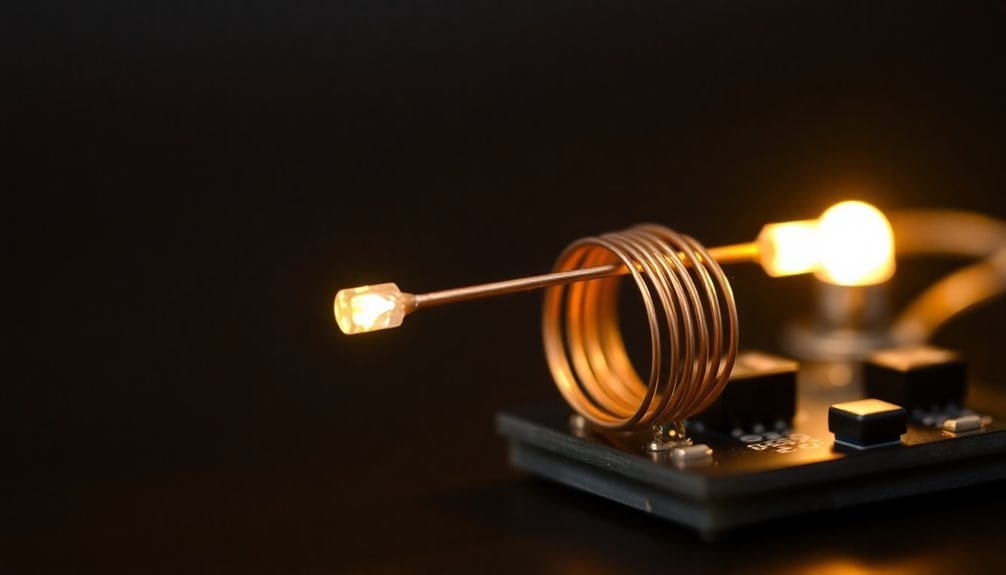
RF antennas serve as essential tools in the passive detection of electromagnetic fields (EMF), effectively capturing and converting RF energy into measurable signals. They operate without external power, gathering EMF energy and directing it through coaxial cables to analyzers. Different antennas, like dipoles and loops, cater to various frequency ranges, impacting sensitivity. You’ll find that antenna orientation affects detection accuracy since field strength can be directional. For practical use, field probes optimize human exposure assessments. Additionally, compliance with regulations ensures that the detection methods used adhere to safety standards, enhancing the credibility of your measurements. Always remember, calibration enhances precision, and understanding your antenna’s radiation pattern is key for reliable measurements in various environments.
Coil-Based DIY EMF Detectors
Coil-based DIY EMF detectors represent a practical solution for enthusiasts and professionals interested in monitoring electromagnetic fields.
These devices utilize a coil of wire to detect changes in the EMF. Here are key components for building your own:
- Materials: Use copper wire, ferromagnetic core, small capacitor, and a detection circuit.
- Coil Design: Wrap the wire around the core, ensuring multiple turns for better sensitivity.
- Detection Circuit: Incorporate amplifiers and filters to enhance the measured signal, allowing for effective readings.
With proper calibration, these detectors can monitor EMF levels in various environments reliably.
Grounding and Capacitive Coupling Methods
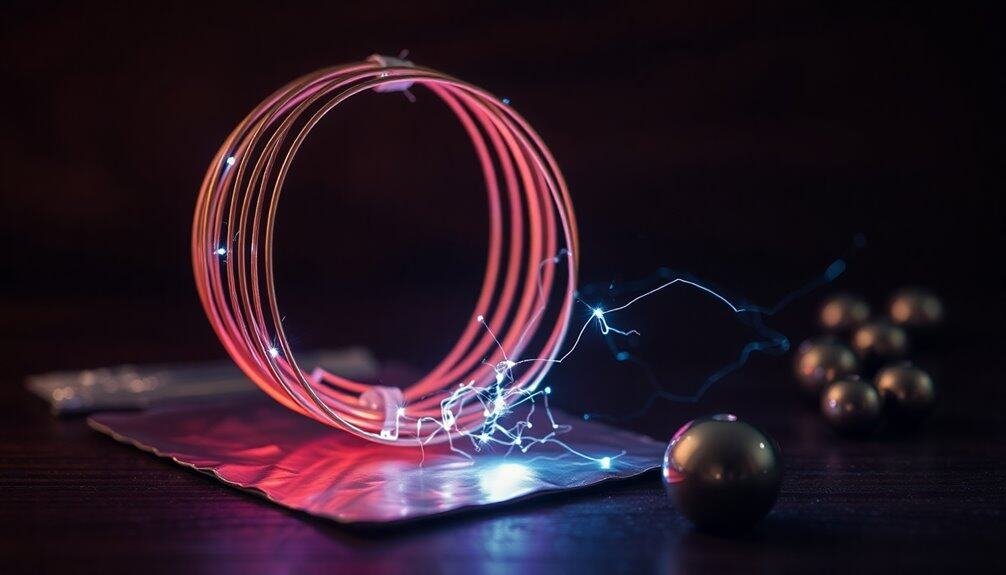
Grounding and capacitive coupling methods play essential roles in the detection of electromagnetic fields (EMFs). Grounding connects electronics to the earth, providing a low-resistance path for unwanted currents.
Seasonal changes impact soil resistivity, making spring and autumn ideal for effective grounding. You can enhance grounding by using biochar or watering areas, both lowering resistance.
Capacitive coupling, involving energy transfer through capacitors, detects EMFs by amplifying weak signals. The capacitance value impacts detection efficiency, while shielding can reduce interference.
Exploring Resonance Techniques for Signal Amplification
When exploring resonance techniques for signal amplification, understanding the fundamental principles of resonant circuits is critical.
These techniques enhance EMF detection by focusing on specific frequencies. Here are three effective methods:
- Series Resonance: This method minimizes impedance, allowing higher frequency signals to amplify effectively.
- Piezoelectric Materials: Using these materials can convert mechanical stress into electrical signals, improving sensitivity.
- Antiferromagnetic Resonance: This technique leverages unique material properties for detecting high-frequency electromagnetic waves, essential for future communications.
Biological Responses as Indicators of EMF
Understanding biological responses to electromagnetic fields (EMFs) offers valuable insights into potential health impacts. Abnormal behavior often signals reactions to EMF exposure, particularly stress or anxiety.
Research indicates ELF-EMFs can alter gene expression, influencing proteins like Bax and Bcl-2, which regulate cell apoptosis. Immune systems may also respond, with cytokine levels changing due to EMF exposure.
Additionally, individuals report mood fluctuations and sleep disturbances connected with EMF contact. These responses vary greatly, reflecting different biological processes.
Innovative Materials for Enhanced Detection
Innovative materials designed for detecting electromagnetic fields (EMFs) leverage advanced properties that enhance sensitivity and performance. These materials enable accurate EMF detection and visualization.
- 2D Quantum Materials: Atomic-scale defects in hBN respond to magnetic fields, allowing nanoscale sensitivity through optically detected magnetic resonance (ODMR).
- Thin Ferromagnetic Films: Cobalt-iron-boron films utilize the anomalous Hall effect, achieving up to 20x sensitivity compared to traditional sensors.
- Optical Waveguide Fibers: FBG sensors integrate ferromagnetic nanoparticles, tracking EMF changes through optical behavior without mechanical alterations.
Such innovative materials present cutting-edge opportunities for precise EMF measurement across various applications.
Future Technologies in EMF Sensing
As researchers explore the next generation of electromagnetic field (EMF) sensing technologies, exciting advancements are on the horizon.
Quantum sensors leverage quantum mechanics for heightened sensitivity, essential in applications like GPS navigation.
MEMS sensors focus on miniaturization, improving precision while monitoring various phenomena.
Graphene Hall sensors utilize graphene’s unique properties to detect magnetic fields, particularly in challenging environments.
Integration with IoT devices allows real-time monitoring and control of electromagnetic environments.
Enhanced applications arise in fields such as medical imaging and autonomous vehicles, where improved navigation and safety are paramount.
Future progress in these technologies promises transformative impacts on EMF detection.
Frequently Asked Questions
Can I Use Household Items to Detect EMF Effectively?
You can’t rely on household items to detect EMF effectively. While they might show some signs of interference, they lack accuracy and reliability. For precise readings, consider using specialized EMF detectors instead.
Are There Specific Plants That Respond Well to EMF Exposure?
Imagine a vibrant garden, suddenly faltering. You might notice plants like maize and clover, responsive to EMF exposure, showing unexpected growth changes. Keep an eye on them; they reveal secrets about electromagnetic fields around you.
How Do I Create a DIY EMF Detector With Minimal Materials?
To create a DIY EMF detector, gather an Arduino board, buzzer, LED, 3 Mega Ohm resistor, and wire. Connect components as instructed, power it with a battery, and you’re ready to detect EMF signals.
What Environmental Factors Can Affect My DIY EMF Detection Results?
When you’re trying to detect EMFs, humidity, temperature changes, and nearby electrical appliances can really mess with your results. Metal obstacles and dense vegetation can also block or distort signals, complicating your DIY efforts.
Is There a Reliable Way to Test the Accuracy of My Homemade Detector?
Yes, you can test your homemade detector’s accuracy by comparing its readings with commercial meters, conducting repeated tests, and analyzing data for consistency. Ensuring component quality and reducing interference will also enhance reliability.
Conclusion
To detect EMF without a meter, use creative techniques like spectrum analyzers and oscilloscopes to visualize signals. RF antennas act as passive detectors, while coil-based designs offer DIY solutions. Grounding techniques can enhance sensitivity, and biological responses may indicate changes in EMF fields. Innovative materials also improve detection capabilities. As technology advances, new methods may provide clearer insights into the invisible waves around us. Stay curious and explore these possibilities further.

